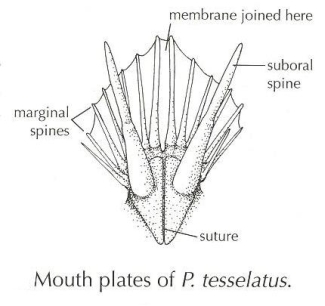Pteraster tesselatus is a stubby five-armed sea star with a central aboral pore. The ends of the arms are upturned to reveal the ambulacral furrow. When collected this species often produces copious amounts of clear mucus. Usually tan, but its colour varies from cream to yellow to a dull grey-purple. The aboral side is occasionally modified by a chequered pattern or dark brown markings in a rough star-shaped pattern. The tube feet are yellow or orange. The arms can grow up to 12 cm long, and the arm-to-disc ratio is from 1.1 to 1.9. The aboral surface is a supradorsal membrane supported by the pseudopaxillar spines with an opening, the osculum, in the centre. The pseudopaxillae have a low base and up to 26 long spines, and 7 or 8 on the periphery. Marginals and other skeletal plates are hidden by the supradorsal membrane. The adambulacrals have a webbed transverse series of 5 to 7 spines. An actinolateral membrane covers half the distance from the furrow to the edge of the arm. Each mouth plate has a membranous fan of 5 to 7 marginal spines and a single large sub oral spine. The fan of one plate is continuous with the fan of the adjacent one.
Characteristics
Similar SpeciesPteraster tesselatus has shorter arms, a smoother aboral surface and generally is a darker colour than Pteraster.
